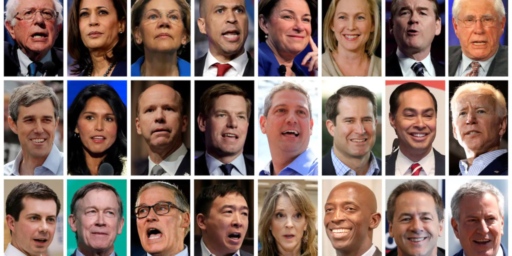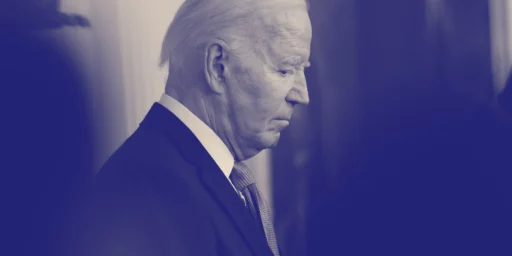Congressman: Abolish Filibuster and Electoral College
Massachusetts Democrat Seth Moulton makes an argument familiar to OTB readers.

The third-term Representative and former Marine got op-ed space in the Washington Post to lay out the case:
Amid the tragedies of the Iraq War, one bright spot always stuck with me: seeing Iraqis vote. They dipped their fingers in ink to prove they voted, and rather than hiding those fingers for fear of reprisal, they walked through the streets holding them high. What they were saying was, for the first time in their lives, their opinions mattered — their votes counted.
That’s the most fundamental requirement of a democracy: Everyone should be able to vote, and every vote should matter. But the uncomfortable truth is, those rights have never truly been guaranteed here in the United States. It’s time to fix what’s broken.
To change the country, we need to fundamentally change how government works: We need to abolish the filibuster and the electoral college.
First, the filibuster. The Senate should require a simple majority to pass legislation, not the arbitrary 60 votes required by the filibuster. A recent New York Magazine article sums up why: “At present, the 26 smallest states are home to roughly 17 percent of the U.S. population. Which is to say: The filibuster allows lawmakers elected by less than 17 percent of voters to exercise veto power over any and all laws. This is a monstrously anti-democratic institution with no parallel in any other advanced democracy.”
[…]
Next, the electoral college. We all know the obvious reason this needs to be replaced with a popular-vote system: In 2016, approximately 3 million more Americans voted for Hillary Clinton than Donald Trump, and yet, Trump is the president. This is not wrong because Trump is a bad president; it’s wrong because it’s unfair to have some Americans’ votes count more than others — just like it was wrong in when a similar thing happened in 2000, 1888 and 1876.
People often defend the electoral college by arguing that without it, presidential candidates would pay attention to only a few states. But that’s already the case because of the electoral college: Two-thirds of general-election presidential campaign events in 2016 were held in just six states, and 94 percent were held in just 12 states. In a winner-take-all-electoral-votes system, candidates campaign only in the states that are a toss-up.
But if we abolish the electoral college — either through a constitutional amendment or a national popular-vote compact — presidential candidates could earn votes anywhere, making them far more likely to campaign everywhere. Then, no matter where you live or how your neighbors vote, your vote would matter. As it should.
I agree with Moulton on the rationale. The execution is the rub.
The filibuster would be the easiest to get rid of. It’s an artifact of another age and a rule the Senate itself could change if it so desired. Indeed, if it did so at the beginning of a new Congress, it could do so by simple majority—bypassing the filibuster. It’s conceivable that this might happen if the stars aligned correctly. After all, the Senate has gotten rid of the filibuster for judicial confirmation under different political parties—for lower court judges under the Democrats and for Supreme Court justices under Republicans.
As noted numerous times here over the years, however, abolishing the Electoral College in favor of direct election of the President would require a Constitutional amendment. It’s simply inconceivable to me that the smaller and more rural states advantaged by the current system would vote to give away the enormous power they now wield in favor of a system where the interests of major metropolitan areas reigned supreme.
Moulton makes oblique reference to the National Popular Vote initiative, which we’ve written about a dozen or so times here over the years, going back to my April 2006 post “Abolishing the Electoral College by Stealth.” It has gained steady traction over the years but not enough to push it over the top. Currently, 12 states, which combine for 172 of the required 270 Electoral Votes, have joined. Whether it constitutes an “interstate compact,” and thus requires Congressional approval under the Constitution, is a hotly-debated but judicially untested question.
Even if we somehow did both things Moulton recommends, the small and rural states would still have disproportionate say in governing the country owing to the Senate. After all, the Electoral College simply mirrors the inequity in Congress in a somewhat different way. But that may be a compromise outcome worth having.





A problem with the National Popular Vote compact is that the secretary of state of any state could unilaterally throw the election by declaring that “ten trillion votes were cast in East Dakota for Jerry Falwell, Jr.” (or what have you). The NPV compact (III-5) makes such declarations absolutely binding on participants.
@alkali: That’s rather silly.
Alkali is being very basic
I’m not sure about getting rid of the Senate filibuster. It does prevent a slim majority, which may not represent a majority of the citizenry, from imposing its will.
Besides, what would Mr. Smith think? (I have to see that movie someday).
What I would do is change Senate and House rules so that the Majority Leader and Speaker, respectively, have to schedule a vote for a) any bill passed by the other house, and b) any nomination submitted by the president (no more hanging Garlands).
As it is, pretty much both these people wield a veto power they shouldn’t have.
Hmm.. I’d add a provision that all laws must be scheduled for a vote within a reasonable time. Sure, either party could slow-walk the other part’s pet initiatives. But they’d also be prevented from rushing their pet initiatives through. 24 hours for legislators to evaluate a 500+ page monster is not reasonable.
Shit, hypothetically it’s way worse than that. You need 41 senators to veto anything, and you can get that with:
Iowa, Utah, Nevada, Arkansas, Mississippi, Kansas, New Mexico, Nebraska, West Virginia, Idaho, Hawaii, New Hampshire, Maine, Montana, Rhode Island, Delaware, South Dakota, North Dakota, Alaska, Vermont, Wyoming.
…and they combine for 11.15% of the population.
The filibuster has to go.
BTW–I don’t even think it would be a small state issue, per se. The issue would be that the GOP sees the EC as and advantage, and therefore would in no way support a change.
@Steven L. Taylor:
Let one Democrat win the EC and lose the popular vote by a very small margin, and then the EC will be an abomination inf the eyes of God and the GOP.
In 92, as I believe I’ve said before, lots of Republican voters were incensed that Clinton was awarded the presidency, although he had failed to win a majority of the popular vote.
Granted that, too, is not exactly a fair result, but at least Clinton won more votes than either Bush or Perot.
@Kathy:
If 59,301 (2.1%) of those who voted for Bush in Ohio in 2004 instead had voted for Kerry, then Kerry would have won the election despite receiving 2.9 million fewer votes. Maybe if Kerry had campaigned more in Ohio….
Now, a 2.1% swing everywhere would have made it a lot more closer, but Kerry would have still received fewer votes, about 531,000.
So, it may very well happen. Though I would really prefer if it didn’t in 2020, Trump would probably lock himself inside a White House toilet and refuse to leave.
Also, the exit polls from 1992 showed that Perot voters would have split evenly between Bush and Clinton.
In my dream world we have a Constitutional amendment that:
1) Restores the “talking filibuster” rules that prevailed until the latter half of the 20th century (closer to the mythical Mr Smith approach than the farce it is today);
2) Removes recess appointments and requires votes on nominees to a position within x months;
3) Plays with term limits for all 3 branches of government (if we can limit a President, the country will survive rolling over members of Congress a bit more often; maybe a single 6 year term for Presidents to avoid the insanity that is members of Congress thinking their job is to obstruct everything a President wants so he can’t get re-elected; a schedule of Supreme Court appointments as otherwise discussed here at OTB instead of lifetime appointments);
4) Puts some teeth into the War Powers Act (and per recent events, the national emergency legislation) and getting authority to declare and maintain military action back where it belongs regardless of how cowardly Congress is about meeting that responsibility;
5) Mandates non-partisan districts;
6) Oh, and establishes that organizations (whether corporations or unions) are not actually “people”.
Basically, focus on making Congress actually semi-functional again, instead of the useless, cowardly, partisan-obsessed failure that acts like it has no actual responsibility unless it involves attacking the other side, instead of being a co-equal branch responsible for actual, effective, government.
In reality of course, the devil is in the details and none of it will ever happen. But I firmly believe Trump is more a symptom of a legislative system (aided and abetted by demagogues in the media) that has become broken beyond recognition, rather than the cause.
The Four Horsemen of the American Apocalypse: Roger Ailes, Rush Limbaugh, Newt Gingrich, and Mitch McConnell.
Also, get off my lawn!
@Teve:
It’s even worse than that when you realize that you only need a hair more than 50% of that 11.15% to get those senators elected. And not everyone votes, so the real percentage drop further. Much further.
@Steven L. Taylor:
That’s fair. There’s something of a chicken-egg thing here (most of the small, rural states are reliably Republican) but it works out the same. I can’t imagine Texas wanting to do away with the Electoral College, even though it would theoretically redound to their benefit, for partisan reasons.
@Kathy:
This scenario is the one most likely to lead to a change, yes.
It’s a fool’s game to engage in “What if?” speculations. Still, I wonder what then-Justice O’Connor would have done in Bush v. Gore, if she had had the ability to foresee how a creature like Trump could slither into the White House despite losing the popular vote nationwide. Also, what PJ said about Ohio in 2004.
@Steven L. Taylor:
Don’t bet money on this scenario. Unless Democrats improve their share of the rural vote the EC will still favor Republicans by large margins.
@Andre Kenji de Sousa: The EC appeared to favor the Dems in 2004 and 2012.
@Andre Kenji de Sousa:
I was speaking simply in terms of which scenario could lead to change. I was not suggesting it was likely.
Maybe they should consider going back to Jeffersonian election and voting rules.
@Tyrell:
I don’t understand what this means. Jefferson didn’t have anything to do with writing the Constitution since he was overseas at the time. Do you mean the rules that were extant during his Presidency? We’ve added a handful of states and 250-odd million people since then.
@James Joyner:
“Do you mean the rules that were extant during his Presidency?”
Perhaps he means the pre-12th amendment rule, when electors did not distinguish between votes for President and Vice President. This created the contested election of 1800, where Jefferson and Burr each got the same number of votes, even though all the electors who voted for them were voting for Jefferson for President and Burr for VP. Maybe throwing the election to Congress to determine which of two members of the same party should hold which office appeals to him.
@Moosebreath:
Anything’s possible, I guess. There’s also a fetish for repealing the 17th Amendment and the direct election of Senators, although I’m not sure how that would fix the problems Moulton seeks to address.
@James Joyner:
“There’s also a fetish for repealing the 17th Amendment and the direct election of Senators, although I’m not sure how that would fix the problems Moulton seeks to address.”
Possibly, though I am not sure why one would refer to going pre-17th amendment as “Jeffersonian”, since it was added to the Constitution when Wilson was President. Likely, we are taking this far more seriously than the original comment is worth, though.
@Kylopod:
It did not. In 2004 if Kerry had won in Ohio by a small margin he would had lost the Popular Vote and won the EC. But that would require him winning large amount of votes(And to do that Kerry would have to have won more votes somewhere, increasing the chances that he wins the PV). The EC favors rural states with large number of white voters, that overwhelming vote GOP.
Nixon wanted to abolish the EC when a Republican had won the South for only one time since the Reconstruction, it’s not a coincidence.
@Andre Kenji de Sousa:
But it would have required a smaller proportion of votes in Ohio than nationally. Bush won the EC by 2.4 percentage points, but Ohio only by 2.1 points. In other words, Kerry was closer to winning Ohio–and thus the EC–than he was to winning the popular vote.
The discrepancy is even clearer in 2012. Obama’s three narrowest victories in that race were Florida, Ohio, and Virginia. But even if you flipped all three to Romney, Romney still would have lost. To change the outcome of the election, Romney also would have had to pick up a fourth state, and the next-narrowest Obama states were Pennsylvania and Colorado, both of which Obama won by about 5.4 points. Yet his national lead was only 3.9 points. In other words, to win the EC, Romney had to do about 1.5 points better in at least one state than he would have to do to win the popular vote. That suggests that (as Nate Silver has argued) if Romney had won the popular vote by a margin of less than 1.5 points, he would have been in strong danger of losing the EC.
What does it mean for the EC to “favor” the GOP? Practically speaking, all it means is that there’s a greater chance of the GOP winning the EC while losing the popular vote than the other way around. That may seem intuitive based on the fact that that’s what happened in two of the last five elections, whereas it hasn’t happened the other way at all. But it’s too small a sample size to determine which scenario is inherently likelier. EC/popular splits are black swan events to begin with, and the 2000 electoral results were extremely questionable anyway. Now you might argue that the fact that the 2000 results were as close as they were while Gore’s popular-vote lead wasn’t shows that the GOP had the advantage. And I’d agree with you! In fact, that’s the exact point I’ve been making. If there’d been a full recount showing that Gore had in fact won Florida (as a lot of the post-election analyses indicated), the results would still have suggested the GOP had the advantage in the EC. And the same is true of the Dems in 2004 and 2012. EC advantages aren’t just discernible when there’s an EC/popular split; they also can be seen by how close or far the losing party was to winning the EC relative to the popular vote.
@Kylopod:
The EC favors small states with large rural populations. Democrats are more reliant on large states. Wyoming and Idaho have more votes in the EC proportional to their population than New York or California.
In theory the right combination of close wins could make a Democrat win the EC and lose the popular vote. But since Democrats have abysmal voting numbers in rural states that’s more likely to happen with Republicans.
And Republicans KNOW this, and they use that when they argue in favor of the EC. Take out California and blah-blah-blah.
To me the problem of contrafactuals is that it’s difficult to imagine a large change of voting in only one state. That was one of the errors of the Clinton campaign: they should have noted that their low poll numbers in Ohio meant that they were vulnerable in Wisconsin, Michigan and Pennsylvania.
@Andre Kenji de Sousa:
But that doesn’t have much to do with what happened in 2016. It wasn’t Wyoming or Idaho that caused Trump to win the EC while losing the popular vote. Indeed, a case could be made that he was put at a slight disadvantage electorally because he did better in those states than Mitt Romney but it didn’t give him any additional electoral votes.
The reason he achieved his EC/popular split was because he did disproportionately well in moderate- to large-sized purple states like Wisconsin, Michigan, and Pennsylvania.
The nature of which candidate the EC favors has to do with how the votes are distributed in swing states versus states that are solidly red or solidly blue. For example, Hillary won about 570,000 more votes in Texas than Obama did four years earlier. But it made no difference to her electorally because she still lost the state. In contrast, Trump won just 452,000 votes more than Romney in the crucial states of WI, MI, and PA–which together have a population slightly higher than that of Texas–and it made all the difference in the world.
That’s why the EC favored Trump relative to the popular vote. Clinton got loads of extra votes that were effectively wasted in states–both blue and red–that didn’t give her any added electoral benefit. Trump, meanwhile, got his extra votes in just the right places.
Nate Silver’s site basically figured this out as early as the summer of 2016 while most other analysts didn’t notice–that Trump’s support tended to be concentrated in exactly the states that mattered while Clinton’s tended to be “wasted” in states that didn’t. The site’s forecasts gave Trump 10-to-1 odds of winning the EC while losing the popular vote compared to the reverse.
However, in 2012 the site had argued the opposite party-wise–that it was Obama who held the EC advantage in that cycle.
As an article from the site noted a few days ago: “Even if these states don’t shift around that much relative to the country overall, they shift around enough to change which party has an Electoral College advantage. For example, in 2016, President Trump’s appeal in states like Michigan, Pennsylvania and Wisconsin caused them to shift just a few points more Republican. It just so happens that that small shift was enough to push them from being more Democratic than the nation to more Republican, which meant the Electoral College gave Republicans a disproportionate advantage in 2016, even though it had given Democrats a disproportionate advantage in 2012. Indeed, the party that has benefited from the Electoral College has bounced around from election to election, seemingly at random.”
@Kylopod:
Overall, Republicans have an EC advantage because they’re simply over-represented. Since the EC is allocated by House seats plus Senators, rural states with small populations all have at least three Electors.
But, yes, because almost all the states use a winner-take-all model, small shifts inside large states can have massive impacts. Through the 1988 election, for example, California was a reliable Republican state and that fact combined with the rural advantage were said to give Republicans a “lock” on the Electoral College. It was said to be next for impossible for a Democrat to win and, aside from the post-Watergate perfect storm, Republicans won EC landslides from 1968 through 1988.
Starting with Bill Clinton’s election in 1992, though, California has been reliably Democrat. So Dems start with a massive advantage but one that is indeed “wasted” as the state becomes bluer and bluer. Winning California by 2 million votes is no more impactful than winning it by 2,000.
@James Joyner:
The problem with that argument is that in every one of those EC landslides, the GOP also won the popular vote by a wide margin. That’s not evidence of an “EC advantage,” it’s evidence of getting more votes, which usually translates to an EC victory–and pretty much always does for popular-vote margins that wide. (The widest popular-vote margin ever for a candidate who went on to lose the EC was Samuel Tilden’s 3-point margin in 1876–and the electoral results there were extremely fishy.)
Chris Cillizza used this same fallacy in early 2016, when he argued that Dems had a near-lock on the EC since 1992 because if you took all the states they’d consistently won in that period and added Florida, it came out to an EC majority.
But, again, Cillizza ignored the fact that Dems won the popular vote in all but one election during this period. An EC advantage isn’t determined by how well a party does in the EC period, it’s determined by how well the party does in the EC relative to the popular vote. In the simplest terms, a party or candidate has an EC advantage if their chances of winning the EC while losing the popular vote are higher than the other way around. But that’s a tricky concept to decipher because the vast majority of the time–at least up to now–the winner of the EC and the popular vote has been the same. As mentioned, Nate Silver’s site was perhaps the earliest to recognize that Trump had an EC advantage. They never considered Trump a favorite to win the EC, but they did consider it far more likely that Trump would win the EC while losing the popular vote than the other way around. In 2012, they argued precisely the opposite–that Obama had a much higher chance of winning the EC while losing the popular vote than Romney did.
Silver’s analysis was based on examining the margins of victory in the states, a factor that was entirely absent from Cillizza’s analysis. For example, while it’s true that Trump was the first Republican to win Wisconsin since Reagan’s 1984 landslide, Dubya twice came within less than half a percentage point of winning the state, and in fact won a larger overall share of the vote both times than Trump in 2016. The idea that Dems had a “lock” on whatever states where they happened to make it just past the finish line for a certain period of time is absurd. States certainly move around in their political allegiances, but they are also affected by how well the presidential candidate is doing overall, and a strong popular-vote victory can help drag seemingly unlikely states across the line, as Reagan did with Massachusetts or Obama did with Indiana in 2008. That’s why the Cook PVI ratings of the partisan lean of states and districts isn’t based on how well the presidential candidates did there in isolation, but how well they did relative to the national vote. So for instance, even though Reagan won MA twice, it still would have had a Democratic-leaning Cook PVI at the time because Reagan won it by a smaller amount both times than his national numbers.
So even when there’s no EC/popular split, a party can still have an EC advantage by how many votes get “wasted” in states that strongly lean toward the party anyway. In 2016, Trump had the advantage, but in 2012 Obama did–even though it had no practical impact in the end.
@Kylopod:
.
More or less. Trump won the EC because he had thin margins in three states in the Midwest, on the other hand Hillary Clinton won the PV because of New York and California – she would only surpass Trump on the PV some days after she had conceded.
Note that in a proportional system the maligned large cities like Chicago, New York and Los Angeles would give an advantage to Democrats. I noted that because in Brazil(A country with similar territorial extension and similar population as the United States) I would see candidates campaigning in large cities and basically no campaign literature being distributed in the suburbs.
In theory the Republicans might win the electoral vote? They might. But they would note that as exception to the rule and wouldn’t defend proportional voting.